The M-346 Master is an advanced and lead-in fifth-generation fighter trainer being developed by Alenia Aermacchi (Italy), a Finmeccanica company. The aircraft is a development of the YAK/AEM-130, a joint programme with Yakolev Design Bureau and Sokol Manufacturing Plant of Russia. In July 2000, Alenia Aermacchi announced that it would cancel the joint project and develop the aircraft alone, as the M-346.
Project Yak / Aermacchi YAK/AEM-130
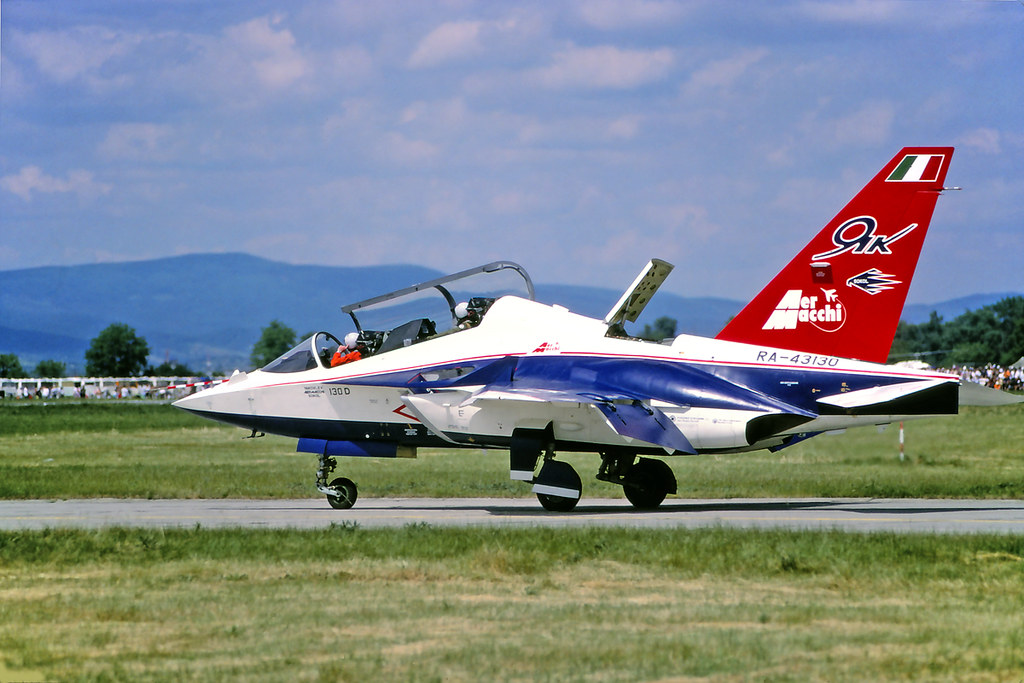 Project Yak / Aermacchi YAK/AEM-130
Project Yak / Aermacchi YAK/AEM-130
In 1992, Aermacchi signed a cooperation agreement with Yakovlev to provide financial and technical support for the new trainer that the firm had been developing since 1991 for the Russian Air Force in competition with the Mikoyan MiG-AT; Aermacchi also gained the right to modify and market the aircraft for the Western market. The resulting aircraft first flew in 1996 and was brought to Italy the following year to replace the aging MB-339. By this point, the aircraft was being marketed as the Yak/AEM-130. In February 1996, Russia provided initial funding for the Yak/AEM-130 and pledged to purchase up to 200 aircraft for the Russian Air Force.
In October 1998, it was reported that the venture was increasingly becoming an Italian-led effort due to a lack of financial support on the part of Russia. By July 2000, Aermacchi held a 50% stake in the development programme, Yakovlev and Sokol had a 25% share each. In mid-2000, it was announced that differences in priorities between the two firms, and a lack of financial backing from the programme’s Russian participants, had brought about an end to the partnership, and that each firm would pursue development of the aircraft independently; Yakovlev received US$77 million for technical documents of the aircraft. Yakovlev would be able to sell the Yak-130 to countries such those in the Commonwealth of Independent States, India, Slovakia and Algeria; while Aeromacchi would be able to sell the M-346 to NATO countries, among others. Source wikiwand.com
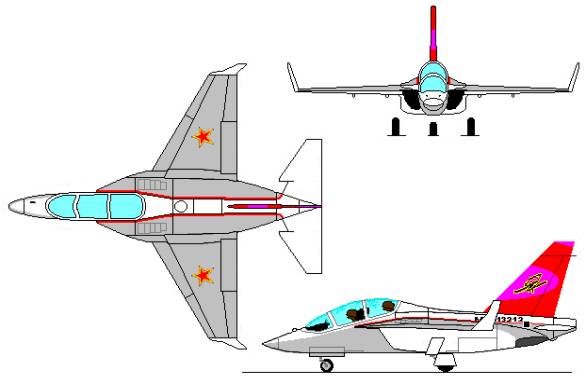 Project Yak / Aermacchi YAK/AEM-130
Project Yak / Aermacchi YAK/AEM-130
The M-346 provides combat pilot training for front line fighters with high angle-of-attack capability. The aerodynamic design of the M-346 uses vortex lift to provide manoeuvrability and controllability at very high angle-of-attack using a fly-by-wire control system.
See details of Yak-130: HERE
 Yak-130
Yak-130
The YAK/AEM-130 has flown in prototype form since 1996. As the Yak-130, the aircraft was selected in March 2002 as the Russian AF’s next generation combat trainer.
M-346 Master fighter trainer development
The M-346 prototype completed its first flight in July 2004. The second prototype made its maiden flight in May 2005. The first low-rate initial production (LRIP) aircraft made its maiden flight in July 2008. The M-346 equipped with advanced helmet-mounted display systems completed its maiden flight in May 2010.
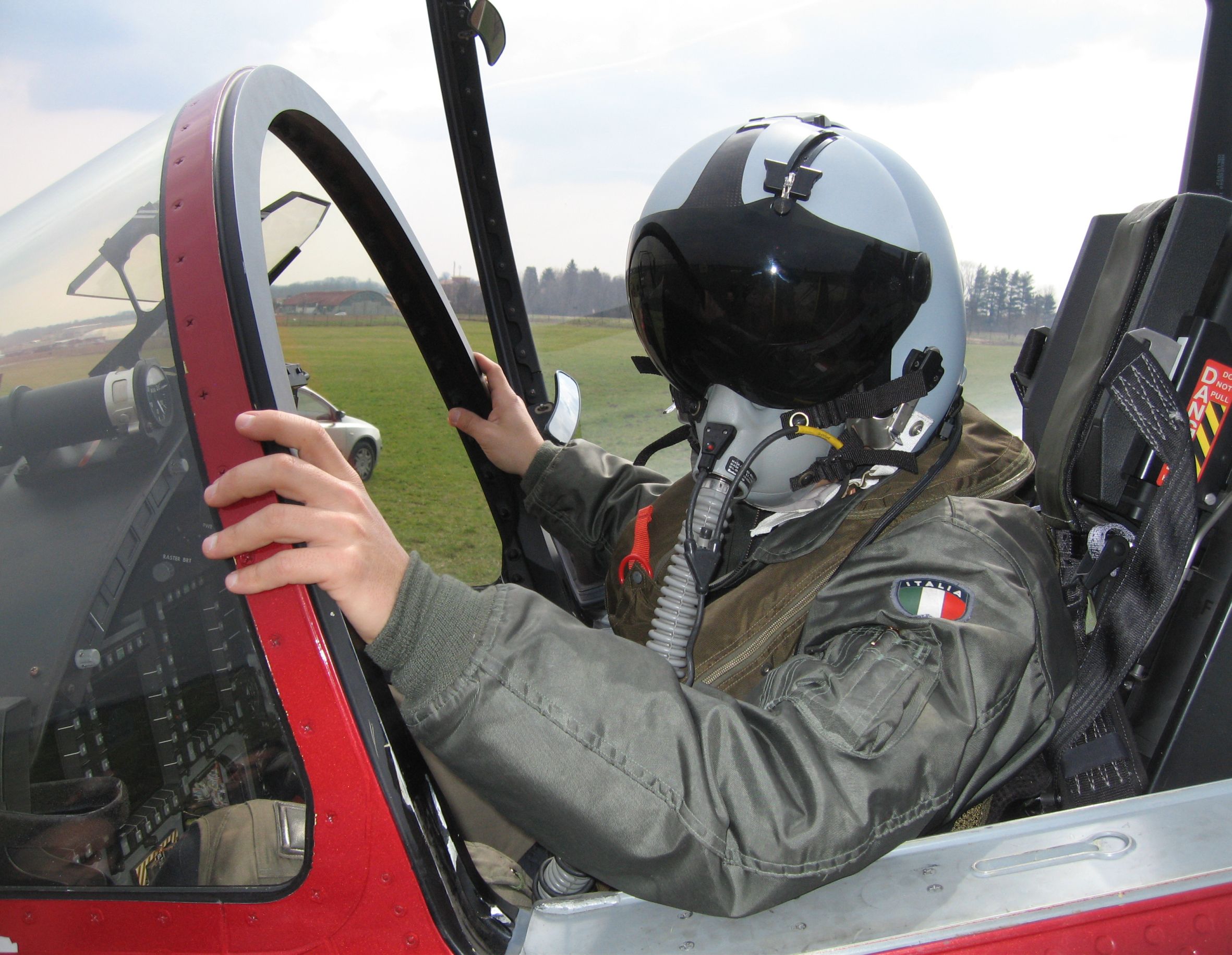 Image @theaviationist.com
Image @theaviationist.com
M-346’s HMD (Helmet Mounted Display), designed by the VSI, the same firm that manufactures the JHMCS (Joint Helmet Mounted Cueing System).
Built around the HGU-55P flight helmet, the new, futuristic device is currently being offered to the Polish Air Force to train student pilots destined to the F-16 Block 52+. Source theaviationist.com
The Italian Air Force (ITAF), the launch customer, received the first batch of 15 M-346 Master aircraft. Alenia Aermacchi signed a €220m ($330m) contract with ITAF in June 2009 to supply six M-346 jets. The first two of the six M-346 aircraft were unveiled in December 2010..
 RIAT 2006 (Royal International Air Tattoo) RAF Fairford (FFD/EGVA), Gloucestershire, United Kingdom 15 – 16 July 2006 Alenia Aermacchi M-346 Master (CMX615), c/n: 6962/001, Alenia Aermacchi, Venegono Superiore, Italy – The first prototype of Aermacchi M346.
RIAT 2006 (Royal International Air Tattoo) RAF Fairford (FFD/EGVA), Gloucestershire, United Kingdom 15 – 16 July 2006 Alenia Aermacchi M-346 Master (CMX615), c/n: 6962/001, Alenia Aermacchi, Venegono Superiore, Italy – The first prototype of Aermacchi M346.
ITAF designated the M-346 as T-346A which made its maiden flight in March 2011. The General Directorate for Aeronautical Armaments of the Ministry of Defence issued the military certification for the M-346 jet on 22 June 2011.
 T-346A “Aggressor” al Tactical Leadership Programme
T-346A “Aggressor” al Tactical Leadership Programme
The first T-346A aircraft was accepted by ITAF in November 2011. The second aircraft was delivered in February 2012. The contract also involves a five-year maintenance and logistics support. The M-346 was successful in its first air-to-air refuelling tests and several techniques performed by ITAF and the company pilots.
M-346 Master training aircraft orders and deliveries

In April 2009, Alenia Aermacchi received the design organisation military approval (DOMA) certificate for the M-346 Master allowing autonomous and direct management of the homologation process including continuation of its airworthiness. DOMA also enables Alenia Aermacchi to streamline M-346 interface with the DGAA (Direzione Generale Armamenti Aeronauticiefficient) and improve internal design and development processes of the aircraft.
In January 2005, the Greek Ministry of Defence signed a memorandum of understanding (MoU) to become a partner in the programme and, in January 2006, Alenia Aermacchi signed an industrial cooperation agreement with Hellenic Aerospace Industry (HAI) under which HAI is responsible for production and assembly of some parts including the rear fuselage.
In May 2006, Alenia Aermacchi announced an agreement with Boeing to jointly market the M-346.
In July 2007, the M-346 flew to the United Arab Emirates for hot weather tests and operational evaluation by the UAE Air Force.
 Image @armyrecognition.com
Image @armyrecognition.com
In February 2009, the UAE announced that it would acquire 48 M-346 advanced lead-in fighter trainer aircraft. Alenia Aermacchi will form a joint venture with Mubadala Development in UAE for establishing the M-346 final assembly line.
ST Aerospace signed a €170m contract with Alenia Aermacchi on 24 June 2011 for providing logistics support to 12 M-346 trainers deployed by the Republic of Singapore Air Force (RSAF). The M-346 jets were ordered by the RSAF in September 2010 under the Fighter Wings Course programme. The first aircraft was rolled out in August 2012 for delivery towards the end of 2012.
Alenia Aermacchi will also supply spare parts, provide repair and overhaul services and render engineering and field support services.
The M-346 trainer was selected by the Israeli Ministry of Defence (MoD) in February 2012. Israeli MoD placed an order with Alenia Aermacchi for 30 M-346 aircraft in July 2012. Deliveries are scheduled to commence in 2014.
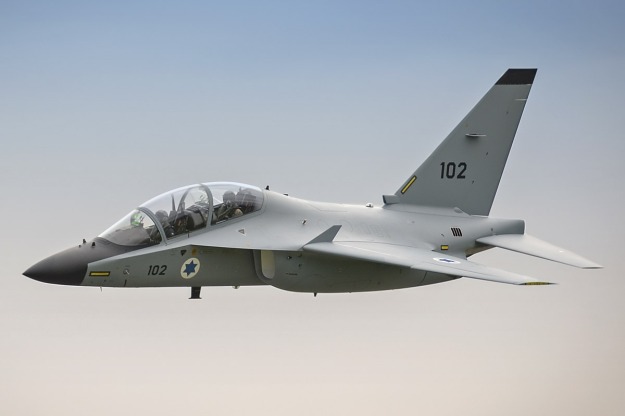 Frst Israeli M-346 Image @airheadsfly.com
Frst Israeli M-346 Image @airheadsfly.com
ITALY ORDERS YET MORE M-346 MASTERS
Italy has raised the number of firm orders for the M-346 Master jet trainer from 9 to 18, aircraft manufacturer Finmeccanica reported on Tuesday 22 March.
The Italian Air Force uses the M-346 as a replacement for the older MB339 in the Lead-In Fighter Training (LIFT) and agressor dissimilar air combat training roles.
The M-346 is operated in southern Italy by the Italian Air Force’s 61th wing at Lecce airbase. Israel and Singapore also operate the type, with Poland set to join this year. Posted 2016/03/22 © 2016 Airheadsfly.com editor Elmer van Hest – Source airheadsfly.com
M-346 weapons
Armaments are carried on nine external store stations, six of which are underwing, equipped with 1,000lb class ejector release units, and two wingtip stations for air-to-air missiles. The under-fuselage station carries avionics pods or a 300l conformal fuel tank.
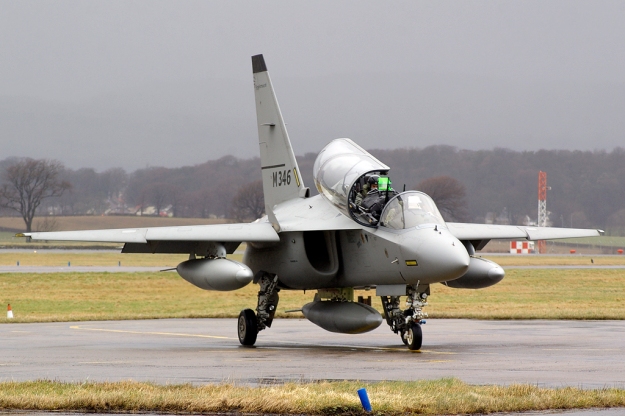 M-346 with 3 conformal fuel tanks
M-346 with 3 conformal fuel tanks
The system data presentation and control functions of the stores management system use any one of the multifunction displays in both cockpits. Hands-on throttle and stick (HOTAS) controls are used to select the weapons. Weapon aiming is controlled by the central main processor, aiming data being presented to the pilots through the head-up display (HUD) or the helmet-mounted display (HMD).
JHMCS II
Digital JHMCS and JHMCS II are highly accurate pilot information systems that provides pilots with “first look, first shot” high off-boresight weapons engagement capability and situational awareness. Both systems enable the pilot to accurately direct (cue) onboard weapons and sensors against enemy targets while performing high-G aircraft maneuvers. The pilot simply points his/her head at the target and weapons will be directed to where the pilot is looking for both airborne and ground targets. As a cueing system, JHMCS II is a two way interface where sensors aboard the aircraft can cue the pilot to potential targets, or the pilot can cue the weapons and sensor systems to areas of interest. Critical information and symbology including targeting cues and aircraft performance parameters are graphically displayed directly on the pilot’s visor.
Virtual HUD
Highway-in-the-sky
Data Link
Blue Forces Tracker
Defensive Systems
Designating and Targeting
CCIP
 DAY SCENE WITH COLOR SYMBOLOGY image @jhmcsii.com
DAY SCENE WITH COLOR SYMBOLOGY image @jhmcsii.com
Detailed Features and Technical Description
- Night module with color symbology is provided by a simple NVG eyepiece replacement kit for fielded NVG F4949/ANVIS-9 NVGs
- JHMCS II displays video, FLIR and data link information in either full view or picture-in-picture view
- Uplook reticles (puppers) for very-high off boresight sensor slewing
- Small diameter, low voltage helmet vehicle interface (HVI) cable
- Cockpit Unit (CU) which provides high voltage is no longer required
- Helmet mounted avionics significantly improve center of gravity and pilot comfort
- Dual visor configuration available
- Visor projected High Definition color video and symbology (800×600 image resolution)
- Standard HGU-55/P Helmet
- Total head borne weight is 4.3 lbs. including oxygen mask
- 28 VDC
- Interface supports MIL-STD-1553, Ethernet, USB, and Wireless
- Fully customizable ICD, display and logic
- Recordable
- Day module is monocular with a 20 degree field-of-view (FOV) off-the-visor projection to the right eye
- The night module combines standard night vision goggles (NVGs) with a unique display that provides symbology and video overlaid on the night imagery
- Capable of displaying both symbology and video
- Symbology and logic can be modified by the customer utilizing an optional software tool without the need for Original Equipment Manufacturer (OEM) support
 MORE INTELLIGENT, MORE CAPABLE, MORE AFFORDABLE image @jhmcsii.com
MORE INTELLIGENT, MORE CAPABLE, MORE AFFORDABLE image @jhmcsii.com
Data jhmcsii.com
The weapons carried include: MK82 500lb and MK83 1,000lb free fall or retarded bombs; rocket launchers; AIM-9 Sidewinder short-range air-to-air missiles; Raytheon AGM-65 Maverick air-to-ground missiles; MBDA (formerly Alenia) Marte MK-2A anti-ship missiles.
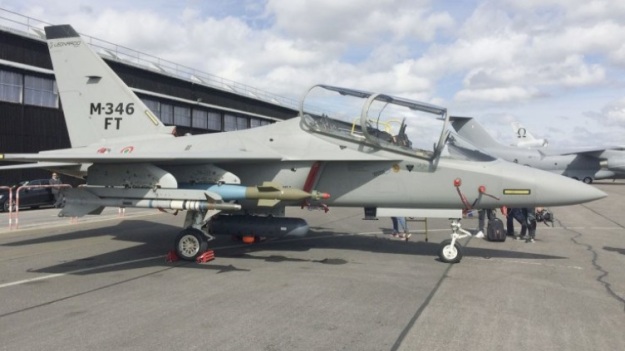
External store integration includes:
- GBU-12 (500 lb) Paveway II LGB
- GBU-49 (500 lb) Enhanced Paveway II GPS/LGB
- Lizard 2 LGB (500 lb)
- GBU-38 (500 lb) JDAM
- Lizard 4 LGB (500 lb)
- Small Diameter Bomb (SDB)
- Rocket Launchers
- MK.82 (500 lb) general-purpose bomb
- MK.82HD Snakeye (500 lb) general-purpose bomb
- Gun pod
- Air-to-Air Missiles
- External Fuel tanks (630 lt each)
- Recce pod
- Target Designator Pod
Source Leonardo – Finmeccanica
GBU-12 (500 lb) Paveway II LGB
GBU-49 (500 lb) Enhanced Paveway II GPS/LGB
Lizard 2 LGB (500 lb)
 Image @defenceindustrydaily.com
Image @defenceindustrydaily.com
LIZARD is an advanced new generation laser-guided bomb used for air-to-surface attacks of a variety of targets that are illuminated by a laser designator.
The LIZARD system features high accuracy, all digital electronics, and compatibility with a broad range of airborne and ground laser designators. The LIZARD modular design provides growth for Global Positioning System (GPS) guidance capability in adverse weather scenario and an alternative Autonomous Imaging InfraRed seeker for attack of a variety of mobile targets. Source nibbio14.altervista.org
Small Diameter Bomb (SDB)
The Small Diameter Bomb (SDB) system is the next generation of low-cost and low collateral-damage precision strike weapons for internal and external carriage. With a range greater than 60 nautical miles, SDB’s precision guidance and compact size allow today’s warfighters to surgically prosecute more targets per sortie.
GBU-39/B Weapon:
• Dimensions: (L x W): 70.8″ x 7.5″ (1.8 m x 19 cm)
• Weapon Weight: 285 lbs. (130 kg)
• Warhead: 206 lb. (93 kg) penetrating blast fragmentation
• Warhead penetration: >3 feet of steel reinforced concrete
• Fuze: electronic safe/arm fuze (ESAF) cockpit selectable functions, including air burst and delayed burst options
• Standoff maximum range: more than 60 nautical miles
• Precision inertial navigation system/global positioning system (INS/GPS)
• Anti-jam GPS and selective-ability anti-spoofing module (SAASM)

The pneumatic SDB carriage allows four weapons to be carried in one aircraft weapon station. The SDB Focused Lethality Munition (FLM) variant incorporates a carbon fiber composite warhead case and an advanced multiphase blast explosive for precision engagements with ultra-low collateral damage outside the blast zone.
BRU-61/A Carriage System:
• Payload capacity: four weapons
• Weight: 320 lbs. (145 kg) empty, 1,460 lbs. (664 kg) loaded
• Dimensions (L x W x H): 143″ x 16″ x 16″ (3.6 m x 40.6 cm x 40.6 cm)
Source boeing.ca
MK82 500lb
MK.82HD Snakeye (500 lb) general-purpose bomb
AIM-9 Sidewinder short-range air-to-air missile
The Sidewinder is the most widespread Air-to-Air missile in the world; its first version, the AIM-9B, entered service in 1953 and since then it has been continuously updated up to the latest versions AIM-9L and AIM-9M and it boasts many imitation attempts, like the Russian AA-2 “Atoll” or the Israeli Rafael “Shafrir 2”.
It features four detachable double-delta control surfaces behind the nose and a roll stabilizing rear wing/rolleron assembly. The main components of the missiles are an infrared homing guidance system with “all aspect” capability, an explosive/fragmentation warhead weighting about 10 Kg and an active optical target detector. According to the avionic system of the carrier aircraft, the missile can be fired in two modes:
- “Boresight Mode”: IR seeker slaved to the aircraft weapon aiming system
- “Scan Mode”: IR seeker performs autonomous scanning
| Length: | 2.87 m |
|---|---|
| Diameter: | 127 mm |
| Wing span: | 0.64 m |
| Weight: | 87 Kg |
| Warhead: | 9.5 Kg HE/fragmentation |
| Fuze: | Active Laser |
| Guidance: | IR |
| Propulsion sys.: | Rocket motor, solid propellant |
| Range: | 8 Km |
Source nibbio14.altervista.org
Raytheon AGM-65 Maverick air-to-ground missiles
Marte MK-2A anti-ship missiles
Sea Killer is an Italian anti-ship missile. It has been built in several versions, with differing guidance systems, and suitable for launching from ships or aircraft (in which form the weapons system is known as Marte).
Marte 2A Modified version of Marte 2 for launch from fixed wing aircraft, with booster rocket omitted.
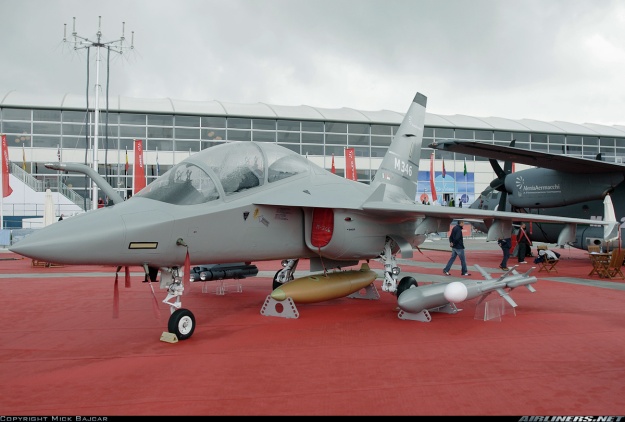 Alenia Aermacchi M-346 Master Photographer Mick Bajcar @airliners.net
Alenia Aermacchi M-346 Master Photographer Mick Bajcar @airliners.net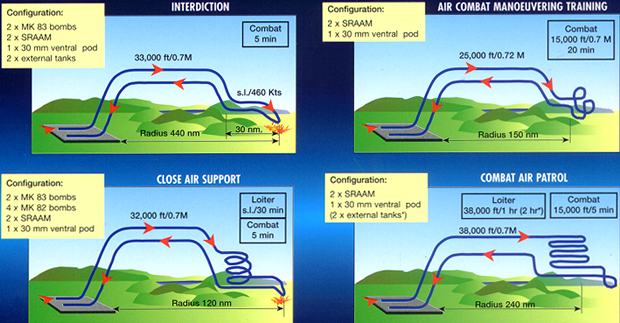
M-346FA
The FA (Fighter Attack) variant, evolution from the M-346FT, is the most suitable response to meet the widest range of customer operational needs. The aircraft is a multi-role lightweight fighter equipped with the multi-mode Grifo M346 radar, produced by the Airborne and Space Systems Division and specifically optimized for the FA variant.
The aircraft represents a highly effective and low-cost tactical solution for the modern battlefield and at the same time it keeps all the features of the M-346AJT (Advanced Jet Trainer), providing the air forces with maximum commonality, operational flexibility and advanced training capabilities.
7 external hard-points are available for the employ of a extensive variety of air-to-air and air-ground weapons (laser/GPS guided and non-guided) and several external loads including gun, reconnaissance or target designation pod.
It is possible to integrate a Tactical Data Link, an extremely complete self-protection system, a Helmet Mounted Display (HMD) system, Voice Command, an Identification Friend or Foe (IFF) system, a Secure Communications system, an electronic warfare pod and a radar cross section reduction kit has been qualified. Source leonardocompany.com
MARTE ER
MARTE ER represents the 3rd generation within the MARTE family of missile systems and is derived from MARTE MK2/S which is already in service with the Italian Navy on its NFH90 and AW101 helicopters. The main difference between the two lies in the introduction of a turbo engine in place of the rocket motor.
MARTE ER missile is going to be integrated on Eurofighter TYPHOON and other fast jets.
MARTE ER’s design takes into account that MARTE MK2/S is already qualified and installed on these two platforms. This offers the following advantages:
Same mechanical, functional & electrical helicopter interfaces
No platform hardware changes required to manage the MARTE ER missile, only software changes to the Store Management System (SMS) are required to manage longer range performance
The helicopter, with the new version of SMS software, is able to operate both MARTE MK2/S and MARTE ER missiles
Same logistic support, in terms of benches, trolley and most handling & maintenance tools and schedule
Weight : 315 kg
Length : 3.60 m
Diameter : Max body diameter : 316 mm
Range : Well beyond 100 km
Speed : High subsonic
Source mbda-systems.com
Brimstone

Brimstone provides a combat proven, low collateral, close air support weapon offering to the fast jet operator the unique capability of engaging a wide range of target types, including fast moving vehicles / vessels in both land and naval environments and in both direct and indirect modes.
The latest generation Brimstone builds upon the successful Brimstone Urgent Operational Requirement (UOR) which deployed the weapon into front line operations with the RAF.
Operationally deployed in the Afghanistan,Libya conflicts, Brimstone has proved to be the weapon of choice with its ability to perform surgical strikes in time critical missions with a true day / night capability.

Brimstone is fully integrated onto Tornado GR4 and is intended for integration on Typhoon and Future Attack Helicopter. The weapon system is also suitable for deployment on a wide range of Unmanned Aerial Vehicles, land and surface platforms.
Combat aircraft armed with the Brimstone weapon offer reach, speed, flexibility, precision and the ability to engage multiple targets with a single mission load. When used from a fixed wing platform, Brimstone provides a rapid response for Close Air Support and Counter Insurgency that is not possible from helicopters alone.
Brimstones’s wide range of target types includes:
- fast moving and manoeuvring vehicles,
- tanks and armoured cars, bunkers,
- naval vessels including swarming and individual Fast In-shore Attack Craft (FIAC).
Source mbda-systems.com

The external hard points can also carry the Vinten VICON-601 reconnaissance pod, laser designator pod, radar warning receiver pod and Elettronica ELT-55 electronic countermeasures pod.
Vinten VICON-601 reconnaissance pod
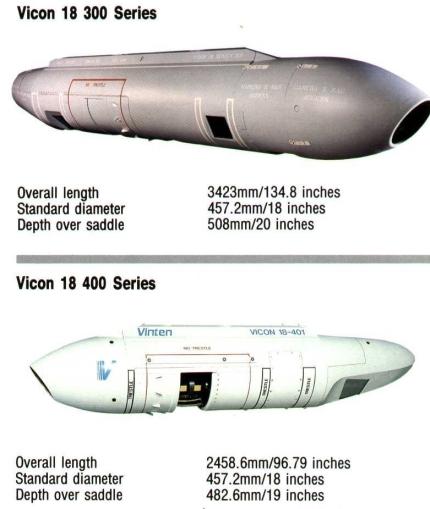 Image @saairforce.co.za
Image @saairforce.co.za
Elettronica ELT-555 electronic countermeasures pod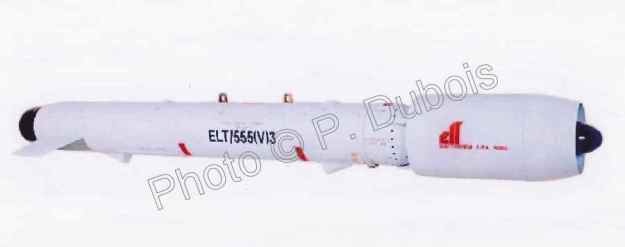
ELT/555 family is an active self-protection systems for fighter aircraft (in pod installation): is designed to provide a wide range of jamming techniques (deception, noise, etc…), suitable to face both traditional and new threats characterized by coherent radar (Pulse, Doppler, Pulse Coded, etc…) associated to AAA, SAM, AI, AAM systems.
Two versions are provided: the former with TWT transmitter and a traditional sectorial antenna is capable to jam at the same time 2 CW emissions and two pulsed emission with low duty, the latter is characterized by a set of rice-transmitting antennas based on solid state Phased Array and is able to manage 4 emissions simultaneously, regardless the duty.
The ELT/555 family systems can operate autonomously, both in threats acquisition and designation threats, or in cooperation with external passive system (i.e.: RWR) Source elettronica-elt-roma.com
**Note there must be a typo error as there is no ELT-55 listed on ELT wibesite
For fighter trainer role, self-protection system functions and simulated tactical scenario threats are presented and monitored on the multifunction displays.
For operational roles, the aircraft is fitted with a radar warning receiver, chaff and flares dispensers, and active electronic countermeasures.
Dual-Role M-346 to Shift From Trainer to Fighter ‘At Flick of a Switch’
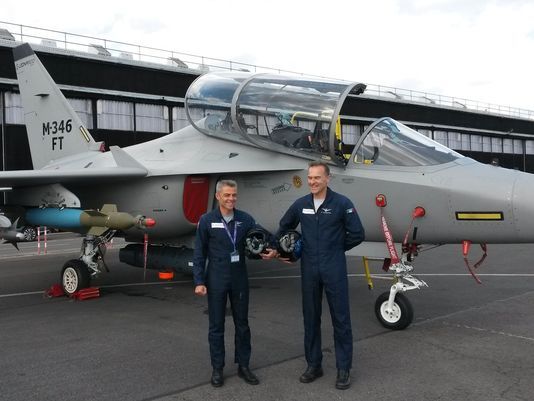 M-346FT – Image @ptisidiastima.files.wordpress.com
M-346FT – Image @ptisidiastima.files.wordpress.com
Italy’s Leonardo-Finmeccanica is promising that its planned M-346 dual-role aircraft will be able to turn from trainer to fighter “at the flick of a switch.”
Managers discussed the program on Friday ahead of the Farnborough Air Show, where the dual-role version of the trainer aircraft, complete with seven hard points, will be shown off.
Massimo Ghione, marketing senior vice president, said the aircraft would be able to fly an armed, operational mission before being handed over to a student for a training mission.
“You could keep the armaments, but with one switch stop them being fired,” he said. “Nobody else can do this,” he added.
With both air-to-air and air-to-ground weapons planned for the aircraft, Leonardo-Finmeccanica is hoping to woo customers looking for the economy of one aircraft doing two jobs.
“We realized customers need an aircraft that can do two missions,” said Ghione.
Leonardo-Finmeccanica will also present at Farnborough a mock-up of the version of the M-346 that will be offered — with Raytheon as prime contractor — in the US TX trainer bid.
Ghione said the offering would differ from the M-346 already in service, which has three cockpit displays. To make the aircraft more closely aligned to the F-35, which has one display, the TX offering would also have one display, he said.
US Air Force TX training fighter
 Model of cockpit of T-100 for the TX program @flightglobal.com
Model of cockpit of T-100 for the TX program @flightglobal.com
The M-346 has now been sold to Italy, Israel, Poland and Singapore, and Ghione said talks were underway with Taiwan, which has a requirement for around 60 aircraft.
Leonardo-Finmeccanica was talking to Taiwanese state firm AIDC about teaming on the development of a Taiwanese trainer based on the M-346, he said. Source defensenews.com
Leonardo go in solo in US Air Force TX training fighter bid: Here
Excerpt
The USAF Advanced Pilot Training Program (T-X) competition took another twist today.
Aircraft company Leonardo confirmed it’s carrying on in the contest for the contract to replace 400 T-38 training jets, which have been in service for over 50 years, as a solo bidder. Leonardo had previously been working in partnership with Raytheon to present the T-100 trainer and its integrated training system as an entrant.

FIA 2016: Leonardo-Finmeccanica unveils M-346FT
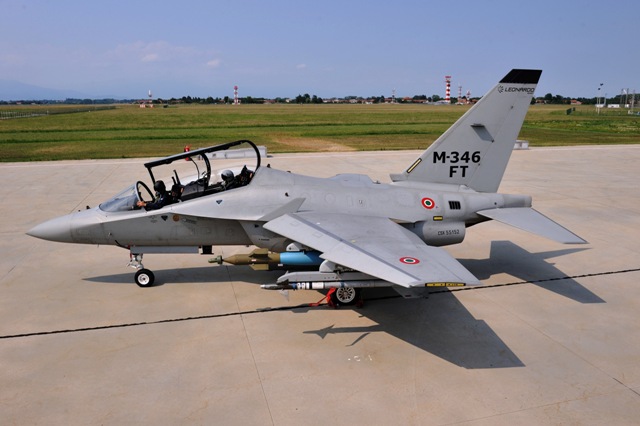 M-346FT – Image @adsadvance.co.uk
M-346FT – Image @adsadvance.co.uk
The Aermacchi M-346FT aircraft – Leonardo-Finmeccanica’s multi-role version of the M-346 trainer aircraft – made its official debut at the Farnborough International Air Show (FIA) today.
The M-346FT (above) is the multi-role version of the M-346, designed to make it easy for pilots to transition from the trainer aircraft configuration to operational mission.
Mauro Moretti, Leonardo’s CEO and General Manager, said: “We Invest in the technological development of highest-added-value activities so that we can stay one step ahead of our competitors. The technological excellence of our trainers is acknowledged worldwide and today we are ready to offer our customers an aircraft capable of combining the operational and training requirements of the Air Forces all over the world, assuring top performances and remarkably lower costs.”
Based on the advanced trainer M-346, the FT (Fighter Trainer) variant integrates a wide range of systems and sensors for tactical support and air defence, a tactical data link, a self defence system, recognition and targeting sensors and a series of weapon systems. This aircraft’s configuration is representative of a basic version with operational capabilities that can be integrate with additional sensors in the future. Posted 11 July 2016 – Original post adsadvance.co.uk
Dual-role M-346FT Fighter Trainer has completed first weapon tests: Here

Excerpt
Testing that took place in Italy in coordination with the Italian Air Force shown the successful deployment of two weapon systems: the Lizard LGBs (Laser Guided Bombs) and the Mk.82 ballistic bombs. Recce and cannon pods are already integrated and fully operational, according to company sources.
Leonardo test fires Sidewinder from M-346: Here
Excerpt
Leonardo has continued development work on the attack variant of its M-346 trainer, performing a successful test firing of a Raytheon AIM-9L Sidewinder air-to-air missile from the platform.
Conducted at Italy’s Salto del Quirra test range off the coast of Sardinia, the firing validates the safe separation of the munition from the aircraft.
Israel to boost M-346 capabilities: Here

Excerpt
The Israeli air force is upgrading the capabilities of its Leonardo M-346 advanced jet trainers, to equip the “Lavi” with inert training bombs and external fuel tanks.
“We work closely with the manufacturer, and this may lead to offering the same upgrades to other customers,” says the commander of the air force’s flight test centre, identified only as Lt Col Shlomy. The unit is tasked with overseeing the modifications, as well as opening the trainer’s full flight envelope, to match the service’s operational requirements.
Cockpit
 Image @military-today.com
Image @military-today.com
The cockpit is representative of the latest-generation combat aircraft, and each crew position is equipped with raster / stroke type head-up display (HUD), full-colour liquid crystal multifunction displays (three in each cockpit), helmet-mounted display with threat simulation capability, night-vision goggle (NVG) compatible instrumentation and hands-on throttle and stick (HOTAS) controls.
The cockpits can be fitted with MK16 ejection seats from Martin Baker of Uxbridge, UK.
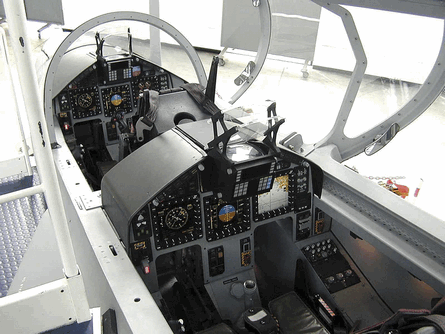
MK16 ejection seats from Martin Baker
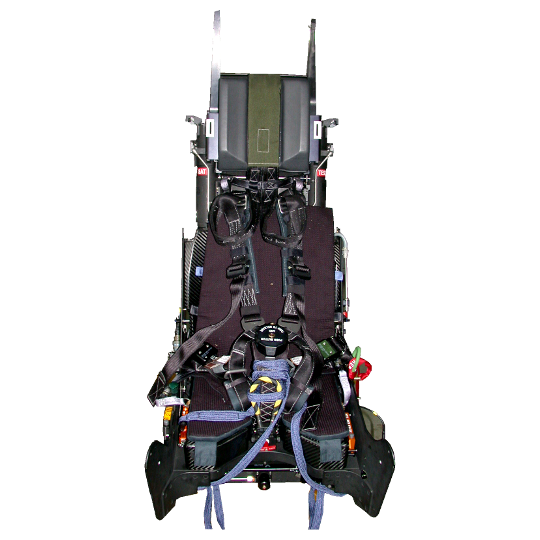
Currently used in F-35, Eurofighter, T-6 Texan II, Rafale and T-38/F-5. Source martin-baker.com
The canopy is hinged on the right, electrically operated and features a bird-proof blast-shield transparency between the cockpits. The canopy can be jettisoned manually from inside or outside the aircraft using an explosive severance system, so there is no transparency-shattering miniature detonating cord obscuring the view. In an ejection, striker arms on top of each seat shatter the canopy. The seats are auto-sequenced, auto-separated and a command eject function is available to the instructor in the rear cockpit. Source flightglobal.com
Avionics
The avionics architecture is based on a dual-redundant MIL-STD-1553B digital data bus which has capacity for additional systems. The communication suite includes a VHF/UHF transceiver and an information friend of foe (IFF) transponder. The navigation suite includes a laser gyro inertial navigation system with an embedded GPS receiver, and a tactical air navigation (TACAN) and VHF omnidirectional radio ranging (VOR/IIS/MB).
The flight control system (FCS) is a full authority digital fly-by-wire quadruple-redundant system, which includes four BAE Systems Italia flight control computers.
The FCS provides the aircraft with controllability up to angles of attack (AoA) of 35° and higher, g-limitation, stall and spin prevention, and maximum Angle of Attack (AoA) limitation.
It can be adapted to various degrees of automation and autopilot modes with reversionary modes featuring automatic selection for use in case of damage or failures.
GRIFO-346 radar

KEY FEATURES
- Multimode, multirole X-band
- Multiple channels fully coherently pulse doppler processed
- Open architecture
- Air cooled, high efficiency TWT transmitter
- Advanced processor
- Broad suite of field proven air-to-air, air-to-surface and navigation modes, high resolution SAR and ISAR
- Full set of ECCM provisions
- Tracking accuracy supporting missiles release and guidance
- Monopulse flat plate slotted array antenna
- Growth capability to extend the existing features, including sensor fusion with IRST
Operational Advantages
- Comprehensive suite of operational modes supporting A/A and A/S missions
- Long range detection and tracking in all scenarios: lookup and look-down, any altitude, any aspect
- High Resolution imaging: sub-metric SAR and ISAR
- Wide scan sector
- Multiple target tracking
- HOTAS and HMD designation
- Modern, effective, flexible, and operationally proven
- ECCM provisions
Design Advantages
- Fully coherent, high efficiency TWT-based, air-cooled transmitter
- Multiple channel receiver
- High rate DSP, wideband waveform generator
- Four waveforms (LPRF, MPRF, MPRF look-up, HPRF), all including range and velocity de-stagger for optimal target detection in any clutter condition
- Embedded scan converter and symbol generator
- Modular software architecture for radar modes update and customisation
Integration with Weapon System
Multiple target tracking supporting accurate weapons aiming
- Compatibility with modern IR missiles (e.g. AIM-9L-M-X, Python 4)
- Support of CCIP and CCRP through precise air-to-surface ranging
TECHNICAL CHARACTERISTICS
Weight < 100kg
Cooling air cooled
Dissipation < 1.5 kW
Average Transmitted Power Class of 200W
Frequency X-band
Scan Coverage ± 60° both in Azimuth and Elevation
Key Parameters
Track while scan 10 targets tracked, 8 displayed
SAR resolution < 1m
Track formation range > 50 NM
Look-up detection range > 60 NM
Source file Finmeccanica Company
Opale 3 Auxiliary Power Unit
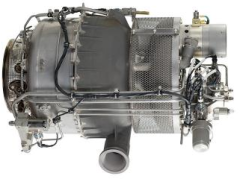
The Opale 3 Auxiliary Power Unit meets all of the needs in terms of secondary power in the M-346 training aircraft developed by Alenia Aermacchi.
The Opale 3 makes the aircraft totally self-sufficient for starting and ground operation, and contributes to operating safety by providing additional main engine restart capabilities in flight.
Its remarkable compactness, combined with a power output among the highest in Safran Power Units range, makes the Opale 3 an APU particularly suited for the most demanding applications, in terms of integration as well as performance.
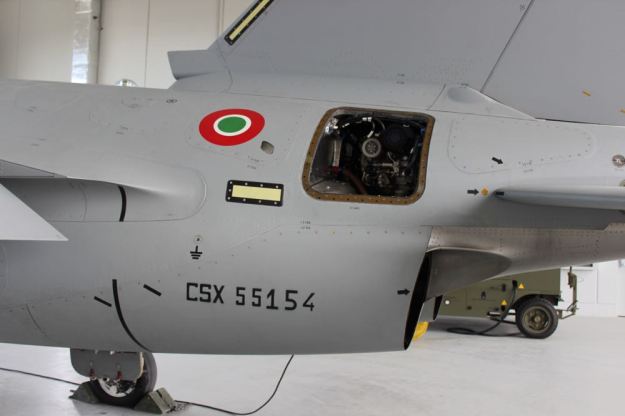
In a small space, it delivers:
- the pneumatic power that is essential for quickly starting the main engines,
- the air-flow rate required to operate the air conditioning system of the cockpit and avionics,
- the electrical power over the on-board network, supplying power to a number of items of aircraft equipment
Source safran-power-units.com
An auxiliary power unit (APU) is fitted that can be used for air supply, engine starting and 28V DC power supply up to 25,000ft. The hydraulic system has one pump per engine, with dual 3,000lb/in2 supply to the primary and secondary flight controls and wheel brakes. Park brake, steering, speed brake and landing gear are driven from the right-hand system, allowing the left engine to be shut down during taxi back after landing. An emergency power system is linked to the left hand supply.
The electrical system has one 20kVA 115V AC generator per engine and left and right transformer rectifier units to give 28V DC power. There are also separate AC and DC external ground-power receptacles on the left-hand side of the nose close to the pressure refuelling panel. Source flightglobal.com
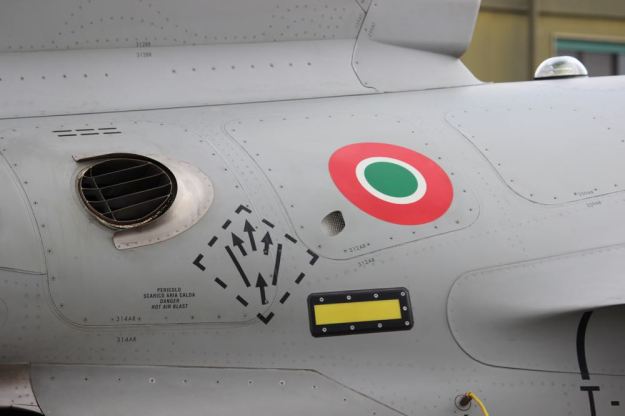 Auxiliary Power Unit exhaust
Auxiliary Power Unit exhaust
Turbofan engines
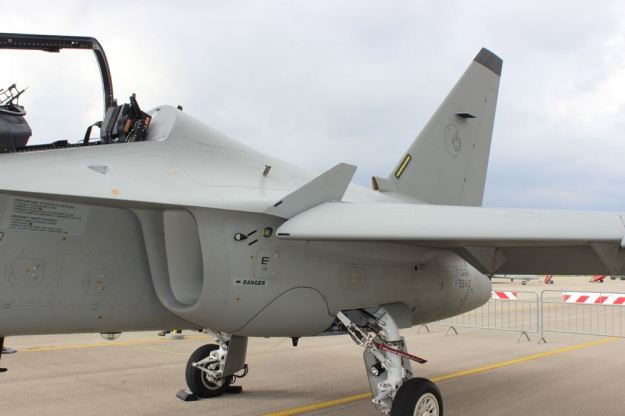
2 x Honeywell / ITEC F124-GA-200 turbofan engines

The F124 is a 6,000-lb of thrust class turbofan engine produced by the International Turbine Engine Company (ITEC), a joint venture of Honeywell and AIDC. The F124 engine is intended to provide reliable and safe propulsion for fixed wing training, light combat and unmanned aircraft. Its features include an advanced dual FADEC control system, modular construction, integrated engine health monitoring system (EMS), and outstanding power-to-weight ratio. Basically, the F124 is a derivative of the F125 engine lacking the afterburner module.
The F124 engine’s efficient and durable design and construction allows for surge free operation throughout the flight envelope. In the early 2000s, the engine was selected by Aero Vodochody of the Czech Republic to power its L-159 advanced training and light combat aircraft. Aermacchi selected the F124 engine to power its M-346 advanced supersonic training aircraft which is expected to enter service by 2010 with the Italian Air Force. The F124-GA-100 is slightly more powerful and heavier than -200 model. Source deagel.com
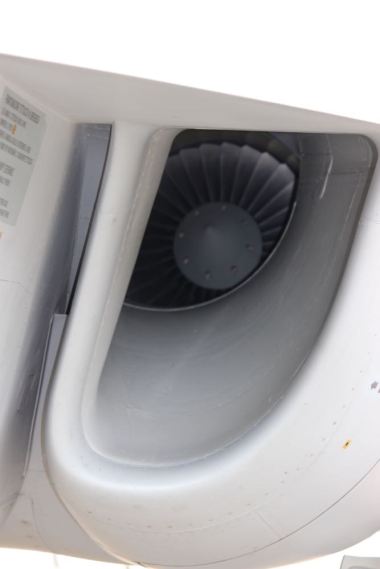
|
Model |
Engine Type | Market | Parameter | ||||
| Max Envelope Diameter | Length |
Takeoff Thrust |
|||||
| inch | cm | inch | cm | Sea Level (lbf) | |||
| F124-GA-200 | Turbofans | Military Trainer / Attack Aircraft | 36.0 | 91.4 | 102.1 | 259.3 | 5870 |
Engine data aerospace.honeywell.com
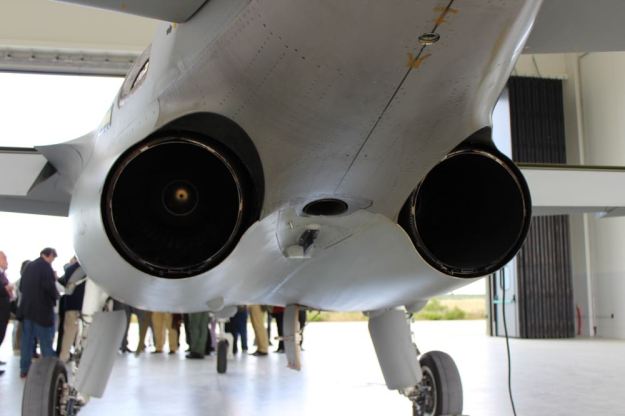
Povazke Strojarne L.M. was to be the supplier of the two DV-2S twin-shaft turbofan engines for the YAK/AEM-130. For the M-346, these are replaced with two Honeywell / ITEC F124-GA-200 turbofan engines, produced with Fiat Avio.
There is also a closed-circuit self-contained aerobatics lubrication system and dual channel Full Authority Digital Engine Control (FADEC).
Performance
The M-346 can climb at the rate of 127m/s. The maximum and cruise speed of the aircraft are 1,092km/h and 1,059km/h respectively. Its stall speed is 166km/h. The range and service ceiling of the M-346 are 2,590km and 13,700m respectively. Its take-off run is 320m, while the landing run is 470m. The aircraft weighs around 4,610kg and its maximum take-off weight is 9,000kg
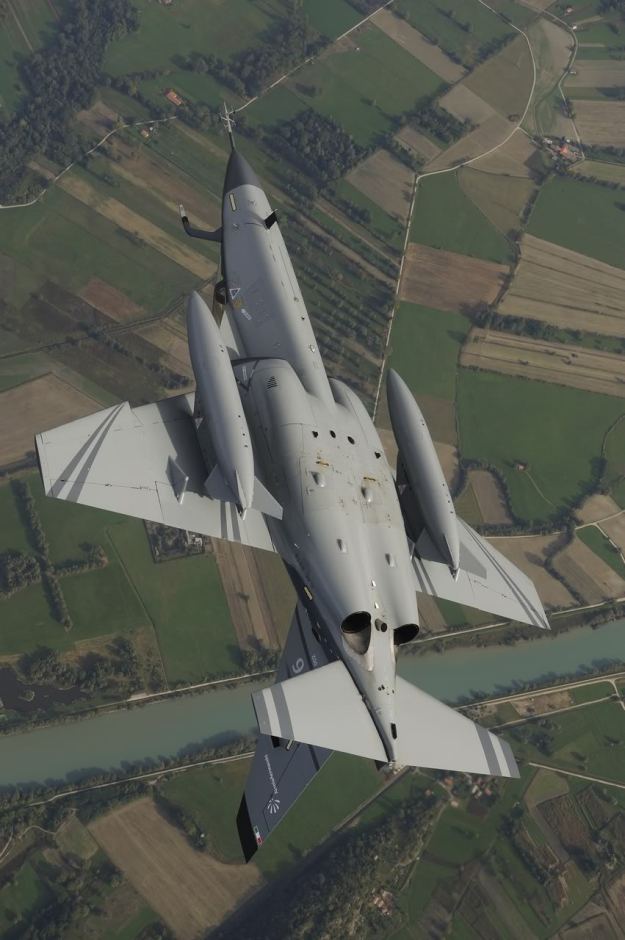
Specification
| Entered service | 2011 |
| Crew | 2 men |
| Dimensions and weight | |
| Length | 11.49 m |
| Wing span | 9.72 m |
| Height | 4.98 m |
| Weight (empty) | 4.61 t |
| Weight (maximum take off) | 9.5 t |
| Engines and performance | |
| Engines | 2 x Honeywell F-124-GA-200 turbofans |
| Traction (dry / with afterburning) | 2 x 27.8 kN |
| Maximum speed | 1 255 km/h |
| Service ceiling | 13.7 km |
| Range | 1 890 km |
| Combat radius | ~ 550 km |
| Armament | |
| Cannon | ? |
| Missiles | ? |
| Bombs | ? |
Specification data military-today.com
Main material source airforce-technology.com
Updated Dec 20, 2017



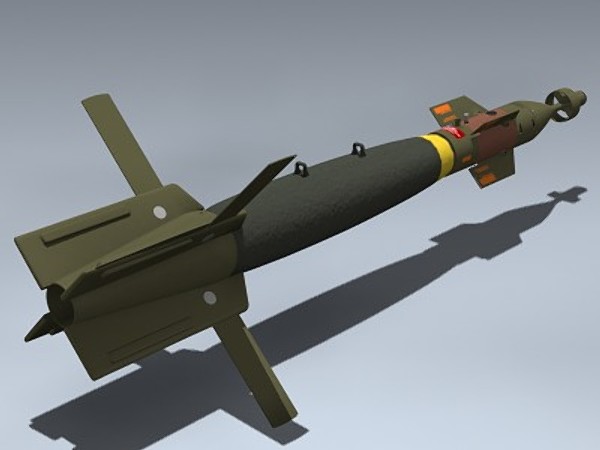

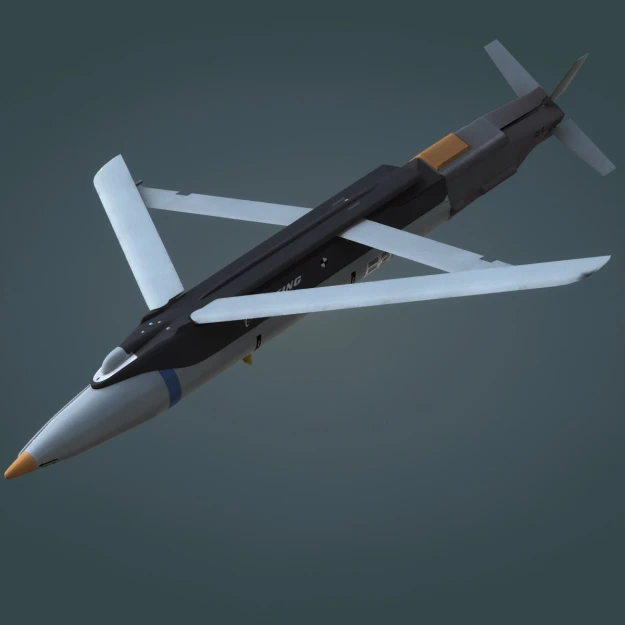

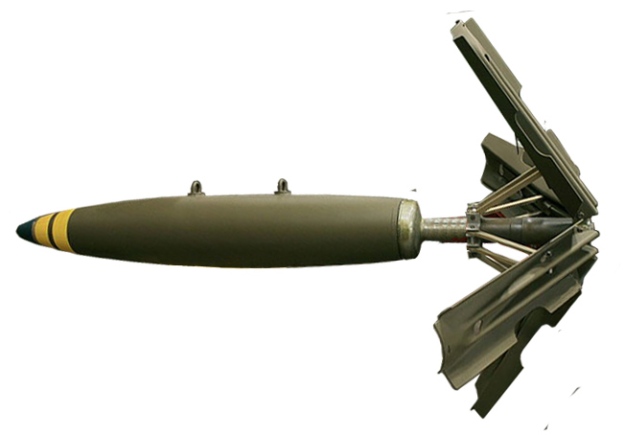
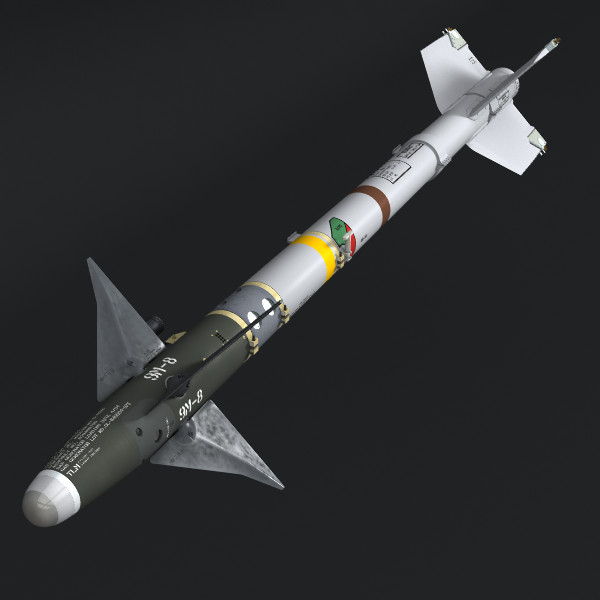







Pingback: Leonardo M-346FA - prima comanda - Romania Military